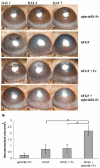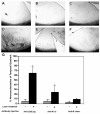Novel aspects of corneal angiogenic and lymphangiogenic privilege
- PMID: 20100589
- PMCID: PMC3685179
- DOI: 10.1016/j.preteyeres.2010.01.002
Novel aspects of corneal angiogenic and lymphangiogenic privilege
Abstract
In this article, we provide the results of experimental studies demonstrating that corneal avascularity is an active process involving the production of anti-angiogenic factors, which counterbalance the pro-angiogenic/lymphangiogenic factors that are upregulated during wound healing. We also summarize pertinent published reports regarding corneal neovascularization (NV), corneal lymphangiogenesis and corneal angiogenic/lymphangiogenic privilege. We outline the clinical causes of corneal NV, and discuss the angiogenic proteins (VEGF and bFGF) and angiogenesis regulatory proteins. We also describe the role of matrix metalloproteinases MMP-2, -7, and MT1-MMP, anti-angiogenic factors, and lymphangiogenic regulatory proteins during corneal wound healing. Established and potential new therapies for the treatment of corneal neovascularization are also discussed.
(c) 2010. Published by Elsevier Ltd.
Figures






























Similar articles
-
Corneal angiogenic privilege: angiogenic and antiangiogenic factors in corneal avascularity, vasculogenesis, and wound healing (an American Ophthalmological Society thesis).Trans Am Ophthalmol Soc. 2006;104:264-302. Trans Am Ophthalmol Soc. 2006. PMID: 17471348 Free PMC article.
-
Corneal neovascularization.Curr Opin Ophthalmol. 2001 Aug;12(4):242-9. doi: 10.1097/00055735-200108000-00002. Curr Opin Ophthalmol. 2001. PMID: 11507336 Review.
-
Wound healing fibroblasts modulate corneal angiogenic privilege: interplay of basic fibroblast growth factor and matrix metalloproteinases in corneal angiogenesis.Jpn J Ophthalmol. 2010 May;54(3):199-205. doi: 10.1007/s10384-010-0801-5. Epub 2010 Jun 25. Jpn J Ophthalmol. 2010. PMID: 20577852 Review. No abstract available.
-
Lymphangiogenesis Guidance Mechanisms and Therapeutic Implications in Pathological States of the Cornea.Cells. 2023 Jan 14;12(2):319. doi: 10.3390/cells12020319. Cells. 2023. PMID: 36672254 Free PMC article. Review.
-
MT1-MMP modulates bFGF-induced VEGF-A expression in corneal fibroblasts.Protein Pept Lett. 2012 Dec;19(12):1334-9. doi: 10.2174/092986612803521639. Protein Pept Lett. 2012. PMID: 22670674 Free PMC article.
Cited by
-
CXCL12/CXCR4 axis regulates neovascularization and lymphangiogenesis in sutured corneas in mice.Mol Med Rep. 2016 Jun;13(6):4987-94. doi: 10.3892/mmr.2016.5179. Epub 2016 Apr 25. Mol Med Rep. 2016. PMID: 27121088 Free PMC article.
-
MMP-7 knock-in corneal fibroblast cell lines secrete MMP-7 with proteolytic activity towards collagen XVIII.Curr Eye Res. 2010 Sep;35(9):799-805. doi: 10.3109/02713683.2010.494239. Curr Eye Res. 2010. PMID: 20795861 Free PMC article.
-
Treatment of Corneal Neovascularization Using Anti-VEGF Bevacizumab.J Ophthalmol. 2014;2014:178132. doi: 10.1155/2014/178132. Epub 2014 Mar 23. J Ophthalmol. 2014. PMID: 24778865 Free PMC article.
-
Wound healing after keratorefractive surgery: review of biological and optical considerations.Cornea. 2012 Nov;31 Suppl 1(0 1):S9-19. doi: 10.1097/ICO.0b013e31826ab0a7. Cornea. 2012. PMID: 23038040 Free PMC article. Review.
-
Hemangiogenesis and lymphangiogenesis in corneal pathology.Cornea. 2012 Jan;31(1):74-80. doi: 10.1097/ICO.0b013e31821dd986. Cornea. 2012. PMID: 22030600 Free PMC article.
References
-
- Abbas A, Khan B, Feroze AH, Hyman GF. Thalidomide prevents donor corneal graft neovascularization in an alkali burn model of corneal angiogenesis. J. Pak. Med. Assoc. 2002;52:476–482. - PubMed
-
- Abdiu O, Van Setten G. Antiangiogenic activity in tears: presence of pigment-epithelium-derived factor. New insights and preliminary results. Ophthalmic Res. 2008;40:16–18. - PubMed
-
- Abedi H, Zachary I. Vascular endothelial growth factor stimulates tyrosine phosphorylation and recruitment to new focal adhesions of focal adhesion kinase and paxillin in endothelial cells. J. Biol. Chem. 1997;272:15442–15451. - PubMed
-
- Acuff HB, Sinnamon M, Fingleton B, Boone B, Levy SE, Chen X, Pozzi A, Carbone DP, Schwartz DR, Moin K, Sloane BF, Matrisian LM. Analysis of host- and tumor-derived proteinases using a custom dual species microarray reveals a protective role for stromal matrix metalloproteinase-12 in non-small cell lung cancer. Cancer Res. 2006;66:7968–7975. - PubMed
Publication types
MeSH terms
Substances
Grants and funding
LinkOut - more resources
Full Text Sources
Other Literature Sources
Miscellaneous

